Posts filed under 'Features'
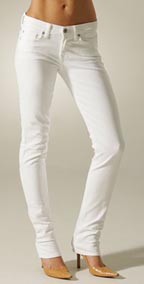 We asked: Are Skinny Jeans In or Out?
We asked: Are Skinny Jeans In or Out?
You said:
It seems that Skinny Jeans are still in style…for now. Almost half (47%) of you think they’re in style. However, 28% think they’re on their way out, and 25% believe that they’re already Out.
Omiru’s take: While skinny jeans appear to be hanging on to their place in the spotlight, don’t count on them sticking around for too much longer. Already, they’re seen as passé in Britain, and they seem to be losing their appeal in the US, albeit slowly. We like the look of skinny jeans, but we find them difficult to wear, as they accentuate figure flaws. If you do sport the look, we recommend pairing the jeans with heels to elongate the leg. Flats provide a more casual look, but we caution against them unless you have the leggy figure of Sienna Miller.
Next Question: What do you think about Military-inspired fashion? Are they In, or are they Out? Cast your vote on the sidebar!
April 24th, 2006
What’s new in fashion media? We can’t wait to see the Modus Project, a Southern California-inspired fashion magazine (and web site and fashion event) created by the students at Otis College of Art + Design. Read on to hear–straight from publisher Don Meek’s mouth–what makes the Modus Project special, the inspiration behind the project, and a sneak preview of what the magazine will feature.
Omiru: In a nutshell, what exactly is the Modus Project, and what makes it unique?
 Don: The Modus Project is a fashion, culture and lifestyle magazine, web site and fashion event. It’s a collaboration between Primedia’s Action Sports Group (ASG) and the students at Otis College of Art + Design. We (at the ASG) provide the publishing backend, but the kids at Otis are the creative engine behind the Modus Project.
Don: The Modus Project is a fashion, culture and lifestyle magazine, web site and fashion event. It’s a collaboration between Primedia’s Action Sports Group (ASG) and the students at Otis College of Art + Design. We (at the ASG) provide the publishing backend, but the kids at Otis are the creative engine behind the Modus Project.
O: What was the inspiration behind the Modus Project?
D: The project really is an outgrowth of our desire to play in the juniors space. We were closing SG magazine (a magazine geared towards surfing girls), and I thought there had to be a way that we could cover fashion and the energy of the Southern California culture. I had heard about Otis from the CEO of QUIKSILVER, Bob McKnight, he’s on the board and his daughter goes to school there. They were doing a fundraiser last October, and Bob asked us to buy a table. It was a great cause, so of course we agreed. I was driving down the road the day we announced that we’d be ceasing publication of SG , and it hit me that we could partner with the students at Otis and create a whole new kind of fashion publication.
O: How is the staff organized?
D: The students are organized into four teams, each with an art director and a photographer, and each team is responsible for a photo-driven 12-page story.
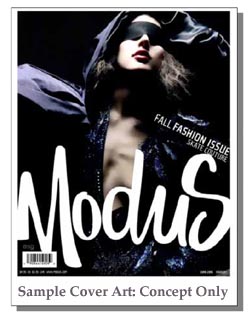 O: Can you give us a preview of what’s going to be in the magazine?
O: Can you give us a preview of what’s going to be in the magazine?
D: The four story ideas are (1) Extended Family, which uses the family metaphor to explore Southern California lifestyle culture, (2) City of Angels, which follows a tribe of skateboarders going from Venice Beach down to Downtown LA with post-apocalyptic imagery, (3) Lineup, which explores interesting fashion juxtaposed against very pedestrian lines (e.g. the line at Starbucks, the line at the bathroom, etc), and (4) Neurotica, my personal favorite, which gives fashion prescriptions for people’s fears. For fear of heights, for example, we have a six foot tall model on six inch platform heels, surrounded by a sea of little people. It’s psychologically interesting.
O: How long did it take to transform the Modus Project from idea to reality?
D: It was last September that we first started talking about the project. I met with the president of the school and the head of the fashion department. In October, I met with the school’s department chairs. We collectively decided to make this a Spring semester project for the students. It was really a perfect fit between Otis, and us, since they were already looking for an interdisciplinary project with a tangible result. We’re hoping to make the Modus Project a permanent part of the Otis curriculum.
O: What other magazines, if any, served as inspiration for the Modus Project?
D: Paper, Nylon, Black Book, Look-Look, and Monster Children from Australia are among our inspirations. However, our format is different. We have an oblong format. Plus, we’re distributing in polybags, so we can do things with the cover that we couldn’t if it were in a traditional newsstand format.
O: What sort of things are you free to do with this alternative format?
D: For one, we don’t have to worry about cover blurbs. We can also put our logo in a different place. Normally, we’d have to adhere to certain conventions, but since it’s not being sold on a newsstand, we can experiment much more freely.
O: Tell us a little more about your background and how you got here.
D: I’m from a media and entertainment background but have been part of the surf industry off and on for a long time,. As a lifelong surfer my questions are: How do you serve a growing market that has limited options? How do you communicate its vitality, energy, and the interest of this Southern California lifestyle? And how do you do it in a way that makes sense? We have sports, the beach, music, and fashion. There’s really a big cultural divide between here and New York, and there hasn’t been a translation of it that has felt authentic. Not to diss Elle and Vogue, but unless you’re a part of this world, it’s hard to get the nuance and the subtleties right.
O: Do explain.
D: Ok, A catalog came in the mail, and I asked my 17 year-old daughter to look at it. She wrote it off after a quick glance. The catalog had teen girls selling swimwear and surfwear, and they got a bunch of models who didn’t surf to do it. It was all wrong…if it were music, I would say that it was off key. The Modus Project is about making sure we’re on key. Really, authenticity is everything, and I feel that we’re in great hands because these kids [from Otis] are the real deal. They’re working artists and designers and are the next generation.
O: Describe your role as publisher of the Modus Project.
D: I’m the head cheerleader for the project. My job is to see that all of the resources are lined up, to get the information to the marketplace, to make sure that the reps understand what it is, to communicate clearly what the value proposition to the advertisers is. In short, it’s my job to run this thing—to empower the creative side, and yet run it as a business.
O: How do you manage that?
D: I’m fortunate to have been part of business organizations with robust creative functions, and while I’m not a “creativeâ€, I love the process and the energy that goes into it.. It’s all about setting up the framework and structure. The rest of it is easy.
O: About what feature of the Modus Project are you most excited?
D: That we’re giving these kids something real that they can have their name on when they leave school. I love watching them light up when we tell them that a million people will be seeing their work. There’s a little bit of a leap of faith that they can pull this off. But having seen their work, and seeing their contributions, I have no doubts that they’ll do just fine.
O: What’s it like to work with the students?
D: Mindblowing. We get stuck in our world of making magazines, and through this project, I think we’re working with some of the best creatives in the industry. These students bring a whole new way of looking at things. I’m amazed by their versatility. They know Illustrator, Photoshop, Flash—when you walk through a list of creative tools, you see that they know everything. I’m amazed by how much they get done with nothing to work with—they’re so resourceful!
O: Give us an example of their resourcefulness.
D: At first, we thought the graphic design kids were just laying out the stories. But they also wanted to help design the logo and the cover. The things they came back with in their first round, with nothing more than a verbal creative brief, were astounding. One girl shot the photos for her cover herself and handlettered and handtinted the art. It was as good as anything you’d see on the newsstands today.
O: What challenges have you faced?
D: We’ve actually had very few crises, and we have had no lack of energy. If anything, we probably want more of the students’ time than they can give us! Case in point: we’re working with a major auto retailer, and they want the students to design the ad for them.
O: Describe the launch of the Modus Project.
D: We’re launching in September 2006 at the Action Sports Retailer Tradeshow with a sheltered launch concept with a 250,000 guaranteed rate base. We’re inserting them in polybags and packaging them with Surfing, Surfer and Snowboarder magazines. We’re also placing our overruns in higher end boutiques such as Fred Segal and Kitson. Research tells us that our readers tend to be influential in their peer groups.
O: Who is the audience for the Modus Project?
D: We’re looking for a national audience. We think that the Southern California lifestyle is universal in appeal. It has a lot of energy that influences rest of the world. There are several cultural axes that the world revolves around—New York, Shanghai, Milan, California. For youth culture, in particular, Southern California is one that’s pretty important.
O: What’s the next big step for you post-launch?
D: In May, we’re going to sit down with the kids, the faculty, and the admins to see if they want to do it again. If they want to, we will immediately get to work on Spring 2007 as a fall semester project.
O: Last words?
D: The Modus Project is really a win-win for both us and Otis. We’re covering fashion territory that we otherwise couldn’t, and we’re giving the Otis students a creative outlet—and money for the pages they’re creating.
Look for the Modus Project this September at Barnes and Noble, packaged with Surfer, Surfing, or Snowboarder magazines.
April 21st, 2006
We asked: Are Leggings In or Out?
You said: It seems that Leggings are Out of style. Only 17% of you think they’re still in style, and a whopping 44% say they’re Out. And another 39% say that they’re on the way out.
Omiru’s take: Though the throwback to the 80s was charming for a short while, it seems that the romance of the past (at least with these leggings) is over. The problem we see with them is that they’re just not super flattering. The short-skirt-over-leggings look that seems to be this year’s frilly-skirt-with-Uggs works for the uber-leggy, but what about the rest of us? And given the wealth of other fashion choices out there, aren’t there more flattering options? Leggings were fun while they lasted, but it’s time to move on.
Next Question: What do you think about Skinny Jeans? Are they In, or are they Out? Cast your vote on the sidebar!
April 17th, 2006
We asked: Is Nautical Fashion In or Out?
You said: Looks like Nautical Fashion is still in. Most (59%) see Nautical Fashion as a Classic, and another 23% believe that it’s a trend that’s still in style. Only 13% think it’s Out of style, and another 5% consider it on the way out.
Omiru’s take: We’re fans of Nautical Fashion, and we definitely think it’s still in. While we do see it as a classic (think: navy blue, crisp white, and Ralph Lauren advertisements), it’s definitely being hyped as a trend…as it has been for the last couple of seasons. While we’re wearing the trend, we’re being mindful of going overboard.
Next Question: What do you think about Leggings? Is it In, or is it Out? Cast your vote on the sidebar!
April 10th, 2006
Ever want to know what a fashion stylist does? Omiru caught up with Alana Kelen (pictured right) and Esther Pak (pictured left), who hold this enviable job at VH1 in New York. Read on to hear about the life of a stylist, stories from on-the-job, fashion foibles, and what’s in and what’s out!
 Omiru: How did you get into the fashion industry?
Omiru: How did you get into the fashion industry?
Esther: I always knew that I either wanted to be a teacher or get into fashion. I chose fashion after taking art classes my junior and senior year of high school. Fashion is something that I fell in love with. I just knew it. If I weren’t on the creative side of fashion, you would find me on the business end.
Alana: Likewise, I always loved fashion. My mom tells me that I would pick out my clothes when I was young, down to the ribbons in my hair. For me, going into fashion was a decision of schools. It was a big decision to go to FIT—you don’t get a fashion degree and then go do something else. It was an all or nothing decision.
O: Describe your career path.
A: I attended FIT, majoring in Buying and Merchandising, which got me into the fashion community. I was lucky enough to land an internship at VH1, and after I graduated, I was hired here as a stylist. It’s a great environment here, and Esther and I are lucky to have consistent work—that’s not the norm in the styling business. We also pick up tons of freelance work—for movies, editorial, and other TV shows.
E: I also attended FIT, majoring in Buying and Merchandising, and interned at VH1. Styling here is a pretty small department, and it’s extremely hard to get a job here even after an internship. I learned so much during that three months though—probably more than I did in all four years of school. After graduating, I went to MTV. But I kept in touch with all of the people I met, and eventually ended up back at VH1.
O: Any advice for aspiring stylists?
E: A smaller environment is better for interning. Here at VH1, I had 2 or 3 people that took me under their wing and they taught me what they knew. Their help landed me freelance jobs afterwards, and to this day, I still use some of the techniques they taught me.
A: Be thorough. Keep your promises. Relationships matter. People remember that we always follow up. How do we do things? No. 1, we give the vendors credit, and no. 2, we give them videotapes showing their clothes on film. We treat it like any business relationship.
E: All of our vendors that we work with love that it’s very personal with us. All of our notes are handwritten. We do our best to get photos of the client in the clothes to send to the vendors. It’s important to us that our vendors know that they’re doing us a favor.
A: The fashion business is all about networking and keeping good relationships with everybody. People jump around in our business. It’s a pretty tight knit circle. So keep in touch with all of the people you meet—contacts are important.
 O: Describe a typical day as a stylist.
O: Describe a typical day as a stylist.
A&E: We usually start our days at the office. When we arrive in the morning, we have to find out what talent we’re dressing, what they like, and then we have to start calling in the clothes. A lot of the job is correspondence, via phone and email. We’re probably on the computer 50% of the day. Appointments are usually scheduled anytime between noon and five. We go out to the showrooms and stores, coming back for fittings later in the afternoon. Fittings usually take an hour, and only about 25% of the clothes typically make it into the final closet. From there, we style out the shoots we need for the next day and send out the clothes. We typically leave between 6 and 8pm, though sometimes we’re here till midnight.
E: We work long days, but we typically switch off and cover for each other. We work as a team, and there’s a nice balance between the two of us.
O: Is that kind of teamwork common in the industry?
E: I would assume that it’s common, but it might be different here because it is such a small department. There’s actually three of us in our department—it’s nice because we’re a tight knit group, and we look out for each other. We even pass off jobs to each other.
O: What was your favorite styling assignment?
E: During my MTV years, I worked on a traveling show called “I Bet You Will.†What I loved about it was the tight knit group of production people. It was a really fun environment, and I liked the fact that there was a lot of traveling involved, along with interesting last minute requests that constantly kept me on my toes, such as being in the middle of Virgina and at 12:30 am making a run to Walmart to get 10 white sheets so I could make 10 togas for 10 half-naked frat boys for one of the ‘bets’.
A: VH1 did a concert for New York after Sept 11. It was such a big event for such a good cause. Everyone broke down all their walls. There were hundreds of celebrities there, and nobody got star treatment. We had one big green room, and everyone was there, which is so unusual. Stylists and crew don’t usually mix with the on-air talent.
O: What kinds of unusual requests have you gotten?
E: A 1970s style suit for a person who isn’t a sample size, a futuristic outfit for someone who’s a XXXL size. You get a lot of last minute crazy moments. During Halloween, my life is easier—you can get costumes the same day. Other times, I’ve been known to pull all nighters creating outfits.
A: I once did a heavy metal makeover with piercings and tattoos. I was up till 3am before a 7am shoot painting and distressing doc martens. I also made an Elvis costume for a guy weighing 400 lbs.
O: Where are your favorite places to shop?
A: We’re bargain hunters. We’re used to doing shows with low budgets, and it’s tough to look at clothes at full price. Some of my favorite places are Loehmanns, H&M, and sample sales.
E: Oh yeah, we’re huge Diesel junkies. Our favorite sample sales are Diesel and Theory. It’s interesting—stylists typically go for the classic kind of look. Solid colors and denim. We dress people in trendier clothes, but we’d recommend more classic pieces.
O: As stylists, do you feel extra pressure to trend it up?
E: Every day, I stand and stare in front of my closet and think, “What am I going to wear?†It’s tough because everyone knows what we do. They think, “What are the stylists wearing today?†You can feel the pressure. However, I generally wear what’s comfortable. Today, I’m wearing Frye boots and jeans.
A: I’ve never felt uncomfortable wearing trousers and a pair of Converse sneakers. I think that if you put yourself together well, it’s ok. We’re running around, on the subway, and all over town. We can’t get all decked out.
E: Yeah, it’s rare that I wear heels. We’re running around, and then we’re down on the ground putting hems up and ripping clothes up. It’s a lot of physical work.
O: What do you think about this increased interest in what celebrities are wearing?
E: It has to do with the fact that we’re saturated with magazines like US Weekly. Everyone has an interest in entertainment interest, and they look up to these celebrities. Fashion magazines used to include actual people doing everyday things. Now, it’s celebrities everywhere.
O: If your house was burning down, and you could only keep one thing in your closet, what would you keep?
E: That’s a tough one—I can’t choose just one! Any pair of jeans that I have, probably one of my pairs of Diesels because they fit me so well. I also have a pair of boots passed down to me from my mom that wore when I was younger. However, my feet are a half size bigger than hers. There are so many pieces that I love that I would want to pass along to my future daughter—my Frye boots, a periwinkle Marc Jacobs sweater, and a big puffy navy pullover hoodie from 8th grade that I always wear…it has special significance to me because it has the name of my school, the year I graduated, and signatures of all of my classmates. I’m very attached to clothes, but even more attached to the memories.
A: An Eggplant Marc Jacobs bag—they’ve since discontinued the color. That, and a one-of-a-kind brown Moschino jacket with flower patches that my mom got for me. Whenever I wear either of these items, people stop me on the street to ask me where I got them.
O: What clothes have you worn that you’re now ashamed of?
E: 2 years ago, I wore one of those mini flouncy skirts. But it was on vacation…so it was “ok†that I wore them. Oh, and years ago, I wore this button down silk blouse that my mom bought me at the Limited. I wore that with a silk vest over it. I’ve also worn flannel mini shorts with black tights and knee-high boots. Oh, and cowboy ankle boots.
A: What she’s not telling you about is her wellies. Every time there’s even the slightest chance of rain, she wears them. 99% of the time, it doesn’t rain—it’s hilarious! As for me, the list would include cowboy boots. I’m not doing them now, but since they’ve come back in, I don’t feel so bad about this one. I’ve also done the French rolling of my jeans with baggy socks. More recently, just a couple weeks ago, I wore these Moschino plaid pants to Fashion Week. I felt like I had pajamas on. I don’t think I’ll ever wear them again.
O: What are you inspired by?
A: I get all worked up about magazines, movies, television, and current events. Pieces of everything inspire me. On the streets of New York, I love people watching. I’m also inspired when I’m meeting the individual I’m dressing. What’s interesting is that our work is so current because it’s TV. We go to Fashion Week every year, but then we use the trends in our own way to make it work for real life. We’re dressing real people.
E: I second that.
O: What are your favorite designers?
A: Stella. We also just saw Versace’s fall collection, which is taking a totally different turn. Francisco Costa taking over the house at Calvin Klein is also doing a great job. My specific favorite, though, has to be Diane von Furstenberg. Her designs are comfortable, wearable, and the patterns are fun. I have four or five of her wrap dresses. But if I had to pick a designer that I look to for inspiration season after season, I ‘d go with Carolina Herrera. She doesn’t ever do wrong.
E: Me too! Beyond that, I’m a huge Proenza Schouler fan. I love the structure and how well everyone seems to fit in it. I also love Narcisco Rodriguez for his simplicity and Michael Kors for his versatility.
O: What up and coming trends do you see?
A&E: Dresses, especially floral, feminine, and A-line styles; shorts of different lengths; nautical (short lived?); simple, solid colors; menswear inspired looks like high waisted, vests, and trousers; necklaces with a lots of layers; gold jewelry; feminine, layered pieces. Jeans are also here to stay. You can wear them anywhere.
O: And what’s going Out of style?
A: The shrug look—it’ll be around for a bit, but it’s going out. Also, peasant skirts, and the miniskirt Ugg look. And the big wooden necklaces that everyone’s wearing. Big necklaces and large bangles, à la Nicole Richie, are going out. Vintage, however, will stick around.
E: But I think Uggs will be back. Not in the form they’re in right now. They’ll have to evolve, but I think they’ll get big again.
O: Last words?
A: I love my job!
E: I feel the same way. However, a lot of my friends think I work in this glamorous environment, going to shows. In reality, though, it’s a lot of work.
A: We love our jobs and interacting with people. However, it is work. We enjoy it and we’re grateful for it, but we’re here from 9 am – 7 pm, and there’s a lot of schlepping, and hard physical work. It’s not as glamorous as one might think, but we live for it. For anyone who is interested in styling or fashion, they should definitely pursue it. There are so many opportunities. You can start your own line, or start styling by making over people you know and go from there.
April 4th, 2006
We asked: Where’s your favorite place to shop?
You said: With 54% of the vote (mind you, this poll was completely unscientific), Cheap Chic rules! Coming in second, with 23% of the vote–online shopping. Specialty stores finished third, with 14% of the vote, and Department Stores, Boutiques, and Sample Sales all came in last, with 3% of the vote each.
Omiru’s take: Can’t say that we’re surprised about the popularity of Cheap Chic….what’s not to love about fashion forward styles at dirt cheap prices. Perfect for trends that you would only want to sport for one or two seasons. Online also had a strong showing, reflecting the growing acceptance of buying style items without the benefit of trying them on first.
We were somewhat surprised, however, by the seeming unpopularity of sample sales. Perhaps it’s because of how we worded the question–what’s your Favorite place to shop. We love a good sample sale (though they’re few and far between), but for practicality’s sake, we do most of our trendhunting at Cheap Chic stores. Oh how we love H&M!
Next Question: What do you think about Nautical fashion? Is it In, or is it Out? Cast your vote on the sidebar!
April 3rd, 2006
Designer isn’t the only occupation on Parris Harris’ resume–fashion event organizing is also his forte. Whether he’s directing models to strut in that certain way, figuring out the budget of his next fashion show, or designing and constructing clothes, Harris is innovative and funky. Although his designs are out there, we definitely appreciate his ability to think outside the box.
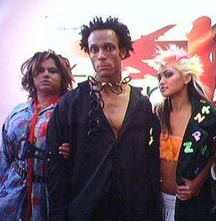 Omiru: How did you get started in fashion design?
Omiru: How did you get started in fashion design?
Parris: Once upon a time, a being by the name of Parris Harris had a love affair with the need to express. This being searched high places like Macy’s Christmas catalog and Kmart’s Super Store and low places like the depth of his soul. I had a love affair with the need to express, especially in places that call for fabulous attire like night clubs, red carpet world premieres, and Texas horse stalls. Overalls can be hot, and if you look hot, your animals may be more responsive to you. You heard it here first, folks. Write it down.
Long story short, I needed outfits, and I first started dressing myself. Fashion or clothing is one of my paints of choice and people’s bodies are notebook pads or expensive pieces of paper to pour all the lovely paints on.
What’s interesting is that circumstances suggest what to wear. They can DOWNRIGHT dress you. Poverty, pride, mourning, death, opulence, regret, sorrow, thug life, wealth, punkness, weddings, racism, hate, conservativeness, etc. I’ve always been observant of how people respond to what others wear and how we act in what we wear. If a 27-year-old accountant went dressed in an Armani suit one day, rags the next, overalls the third, and a Vivienne Westwood couture gown on Thursday, there is a good chance she would be received differently each time based on appearance alone. At some point of my existence, that realization grabbed my attention and kept it.
O: From where do you get your inspiration?
P: From the stars and the moon and the grass that minds its own business and doesn’t bother anybody and just grows. Again, in some way, poverty, pride, mourning, death, opulence, regret, sorrow, thug life, wealth, punkness, weddings, racism, hate, and the conservative all offer inspiration. The power of fashion, the fun aspect, the silliness, the history, the emotions it instills, the actors it suggests, the silence it speaks. Fashion can protect, intimidate, and demean through appearance alone. I’m a sucker for art in unexpected places (performance art) There’s all that to inspire and then some.
O: What is your design philosophy?
P: 1. Make the outrageous understandable, functional, obtainable, and within reach.
2. Make the simple scream while silent (as it does so often) and perhaps cause you to feel that feeling we get when we wished we had looked closer.
3. To cause one to enjoy and appreciate being annoyed (Love thy dreadful neighbor).
4. Make destruction beautiful to the look and acceptable regardless.
5. To enjoy just being dressed.
6. To cause you to enjoy the ugly and never want to be beautiful again.
7. Make the average girls of the club and world, boring, poor, looney and punk, as hot and sexy as the tall, blond, blue eyed, and vice versa.
8. Club wear at the office.
9. To make arty, magnificently animated, nonsense garments.
10. And of course all the other deliciously boring things like making a woman feel feminine or help a gentleman’s outsides match his ego.
O: Thoughts on the San Francisco design scene?
P: Hot, Hot, Hot….Japan mixed with NY and Paris. It’s unaware of its fashion potential. It has the freedom of Paris to wear what you want. It’s courageous. It has trendsetters on the DL (down low) so comfortable in their skin.
O: Who are your favorite designers?
P: Vivienne Westwood, Diesel, Cov’et, Channel, Jncos, Armani, Jimmy Choo, Alberta Ferretti, V.W., Serious, Snoop Dog Clothing, Outkast Clothing, Sean John, Moschino.
O: What trends do you foresee for Spring 2006?
P: New is the new. Pink isn’t going anywhere. Trashy glam with new cuts and lace. Hip Hop Couture. Men in hip, witty, sporty blazers with patches, torn seams, etc. Office meets baseball court in the work place. Punk Proms. Golf Couture. Men in smarter stripes that pop. Women in gowns before 5 p.m. again. The 1700’s revisited, but this time, women in gowns at the water cooler, walking to get the mail, in the mall, and at soccer practice.
O: Last words?
P: I love how clothing can be so accessible. Every day or every moment (depends on the person), we are blessed with the opportunity to change our clothes again…and create again. Is that great, or what?
April 3rd, 2006
With so many printed tees out there, it’s hard to distinguish the posers from the originators. Wonder no more because Local Celebrity, a family owned company (sister Andi is designer for Rebel Yell) is the real deal. And if you don’t buy it, check out the "Posers" section on the Local Celebrity website. Omiru had the pleasure of chatting with Jordan, one-third of the sibling trio. Not only did he set the record straight, but he also let us in on their humble roots and described who a Local Celebrity is.
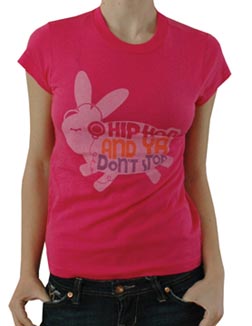
Omiru: How and when did your interest in fashion design start?
Jordan: For me, it was kind of random and not planned at all. My sister Andi [of Rebel Yell] has a fashion degree, my brother has a business degree, and I’m the youngest of the family. I worked at Abercrombie [& Fitch] and retail stores like that, so I always liked clothes, but I never really thought I would end up in the fashion industry. Then we started Local Celebrity and found ourselves in LA 2 years later.
O: When did Local Celebrity come about, and why did you decide to focus on t-shirts?
J: We got a screen printing machine and lived at our grandmother’s house in San Diego and printed t-shirts out of a barn for close to a year. Urban Outfitters was our first account, and they started ordering and needed to really pick up the distribution of the production. We partnered with a production facility, and the rest is history.
O: Who comes up with the concepts for the t-shirts?
J: Primarily it’s me and my brother, but every once in a while, our designer will come up with a good concept or Andi will throw something in there.
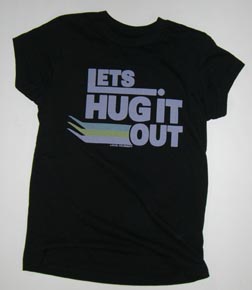 O: How many t-shirts do you come up with per season?
O: How many t-shirts do you come up with per season?
J: We haven’t really been working in seasons. We’ve just been making t-shirts. Ones that sell well, we keep around. Ones that don’t, we just discontinue and replace with another one. We try to get at least 10 a month to our showroom.
O: What makes your collection unique?
J: When we started, it was very unique. We feel like we really influenced the market for humor t-shirts. But now everybody and their mother has a humor t-shirt company. So we stepped it up. It’s not so much clip art and words anymore because that’s everywhere, and we’re tired of seeing it, and we don’t want to wear it. Our shirts have more flavor than other companies. Most of our competition in the humor t-shirt market sell shirts with sexual innuendos, and they talk about getting drunk, partying, and really just the whole college lifestyle (therefore mainly targeting college kids). We try to "rise above" that and keep our shirts clean and wearable for everybody. We want them a little more thought provoking, confidence inspiring, and flavorful.
O: From where do you draw your inspiration?
J: Everywhere. A lot of pop culture and hip hop. Mainly, I like to draw inspiration from music. Everyone can have a Local Celebrity shirt because there’s an occasion for every one of our shirts. Music reaches everybody. We also have random personalities in our family, so we draw inspiration from each other.
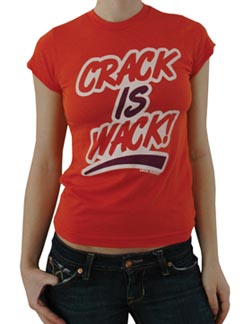
O: Describe your collection.
J: We have fleece, canvas slip on shoes, and hats that are being produced right now, and within the next few months, we’re working on producing long sleeves, thermals, and tank tops.
O: What stores are you sold in?
J: A good list of stores that we’re in are Kitson, Atrium, The Lounge, Urban Outfitters, Hollywood Stars, and Delias.
O: Who wears your t-shirts and who do you want to see in them?
J: We have DJs rocking our stuff, we’ve got Delias customers, and Hot Topic customers. We just want people to wear our stuff and feel confident. Our customer is anyone who keeps it real, anyone who’s cool, has flavor, personality, charisma.
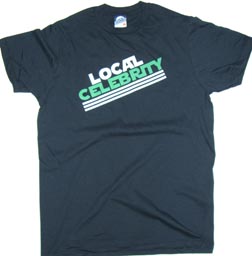
O: From where did you get the name Local Celebrity?
J: It was pretty random. My sister actually came up with it. When it first started, it was called TheVeryBestTshirts.com. We were trying to brainstorm, and it just came to my sister I think when she was going to bed one night. We love it!
O: If your house was burning down, and you could only keep one thing in your closet, what would you keep?
J: I’d definitely rescue my dog, Champ, before I grabbed anything else. He’s a 4 1/2 pound miniature pinscher, and I could never leave him behind. The fire can have my clothes (I have a clothing company, so there’s plenty to go around, and I’d probably already be wearing my Local Celebrity hoodie).
O: Last words?
J: We really wish that people could get to know us because we are the best representatives for the company. That, and our t-shirts are really cool. They have flavor, personality, and it takes a really cool person to wear our stuff.
Get Local Celebrity goods at www.localcelebrity.net.
March 31st, 2006
Billion Dollar Babes: Kate Nobelius and Shelli-Anne Couch
Photo Credits: Billion Dollar Babes
Even if you’ve never had the pleasure of attending a Billion Dollar Babes sample sale, you’ve probably heard amazing things
about it from friends who have. A two-day, invitation-only event held in San Francisco, Los Angeles, New York, Chicago and
London, Billion Dollar Babes attracts roughly 4,000 fashion lovers, who
compete with other shoppers for styles by more than 40 designer labels like Alex Gaines, Blue Cult, Chaiken, Catherine Malandrino, Costume National, Christian Dior, and more.
Not to burst any
shopping bubbles, but did you think the tons of fabulous outfits get
there by themselves? A lot of hard work goes into organizing an event of such scale. Shelli-Anne Couch
of parent company Couch Nobelius is
a major reason for BDB’s success thus far. She and partner Kate
Nobelius handle every aspect of the process, including event
strategy, sponsorship, sourcing, guest list compilation,
pre-event publicity and celebrity outreach (it’s a tough job but someone’s gotta do it!).
Omiru had the opportunity to ask Shelli-Anne–an award winning journalist herself–a few questions about organizing such a massive event.

How did you start your business?
In a one-bedroom apartment in Hollywood with the grand total of one laptop, two phones, one fat contact book and a lot of chutzpah!
What did you have to do to get started?
Operationally,
we just bought items (ie: a printer, another computer as we could
afford them). Strategically, we solidified our film premiere event
production stable while nurturing a fashion idea (that was to become
the global brand of Billion Dollar Babes).
What are some challenges you face as a fashion event organizer?
That
common sense is underated. Seriously. People put square pegs in round
holes all the time! Also, people are never on time.
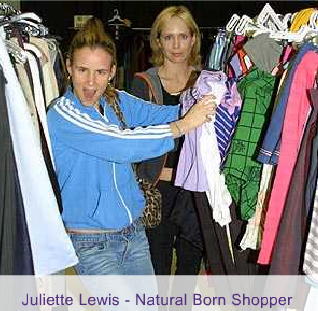 What’s a day in the life of a fashion event organizer like?
What’s a day in the life of a fashion event organizer like?
Liaising
between the fashion client and the media, setting up interviews pre- and
post- runway show, and setting up shoots of the collections.
What do you do to satisfy your clients?
It’s
all about setting and maintaining expectations. When a fashion client
signs on and part of the wishlist is two celebs wearing their clothes
per month and one fashion cover, then by golly, you have to achieve that.
Would you say fashion event organizers wear multiple hats? If so, what are they?
Oh golly, yes. You’re the creative director, publicist, nursemaid, best friend, disciplinarian, and accountant.
How much can one expect to earn as a fashion event organizer?
The sky’s the limit. Some events cost upwards of $500,000 to produce and you’re earning 20 percent of that.
Do some fashion event organizers get paid more?
Absolutely. Why? They’re better! Their client liaison skills meet their creativity
and execution skills, all within the fiscal parameters. They bring an
event in on budget, on time and it looks wondrous.
The Billion Dollar Babes San Francisco sale will run 8am-6pm on Saturday, April 8 at Dogpatch Studios. Everyone is welcome to attend but guests must RSVP online at www.billiondollarbabes.com.
March 27th, 2006
One might think that a designer whose line is sold in
the celebrity-magnet boutique Kitson might be a bit of a diva, but Andi
Ballard of Rebel Yell is as down-to-earth as they come. Even despite
her living in the crazy city of Los Angeles, the Virginia-born Ballard
admits to being a bit of a homebody and doesn’t get star struck by her
celebrity clientele. Omiru got a chance to chat with Andi while she was
sitting through LA traffic.
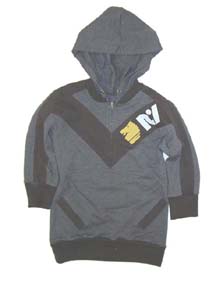 How and when did your interest in fashion design start?
How and when did your interest in fashion design start?
This
is going to sound so corny, but I knew what I wanted to do my whole
life. I would make clothes for myself, and they looked so ghetto
because I’d make them out of towel and whatever I could find around the
house. It was quite a spectacle. I graduated from high school at 16 so
I could start my fashion thing quicker, and I went to FIT in NY. I
graduated from college at 18, and I worked various design jobs in NY
for about 4 years.
What makes your collection unique?
Every
designer is going to interpret something differently. So I would say
that the uniqueness is mainly the way I see things and the way I decide
to interpret them. I love bold colors, I love really really simple
clean graphics, really simple easy clothes.
What are you inspired by?
I
am primarily inspired by anything and everything vintage. But I am also
inspired by what I want to wear. I love vintage clothes, but I steer
away from them because I just feel like a haggard when I wear them.
However, my love of vintage shows in the details I add into Rebel
Yell. I try to make Rebel Yell clothes more updated. It just makes a
woman feel better about wearing vintage.
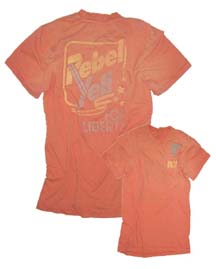 Do you follow trends?
Do you follow trends?
I follow fashion because
I’m a girl and I shop like crazy. In that sense I know what’s going on
trendwise, and I also know when I want something and it doesn’t exist.
It’s very helpful when you’re a designer because you can then design
it. But do I follow trends? No. My previous experience as a designer
when I was in New York was all about using the trend books to do all
the forecasting. A few of my bosses actually told me ‘You cannot do
your original design. You have to knock off blah blah blah.’ And so now
that I have my own company, I definitely made a conscious decision to
not follow trends.
Can you describe what pieces are in your collection and who wears your collection?
The
pieces in my collection are causal, mainly made out of cotton:
T-shirts, different types of cute sexy tops for women, and hoodies. We
have really cute coordinating hoodies with sweatpants that are coming
out. It’s mainly a casualwear collection. But it’s definitely for
someone with style. I don’t really want to see it on people that just
wear what’s on the mannequin. I want someone with their own personal
judgment.
If you were to design a new product line to add to your current business, what would it be?
I
am dying to get into sweaters and into underwear. I’m itching to do
that, and that’s the next step. I just want really cute … the problem
is that companies put out really fun and cute stuff, but it feels
cheap. On the other hand, a company can put out really good quality
stuff but it’s so boring and typical. I want to do a hybrid.
How has your style evolved over time?
It
doesn’t really. It kind of stayed the same. I’m super t-shirt and
jeans. Six-and-a-half days a week, I’m wearing a t-shirt and jeans.
Do you care about what you wear?
Well,
I don’t have time to think about what I wear, and that’s part of what
Rebel Yell is too. It should be something that doesn’t take too much
thought. You throw it on and feel good about how you look.
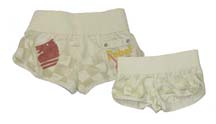 What’s
What’s
your definition of style?
I
think everybody can have style if they want to, but I think there’s a
lot of people that don’t right now. I would define style as when
someone puts an outfit together and it looks good even if it’s not
something that you would necessarily put together. Style is when you
look at the outfit on them and it matches their personality.
If your house was burning down, and you could only keep one thing in your closet, what would you keep?
Ok, am I naked when my house is burning down or am I fully clothed?
That’s a very good question. I think you’re naked.
A
bath robe (laughs). I don’t know if I’m naked. I would say because I’m
such a simple girl, and I’m always in a t-shirt and jeans, I would grab
my Mr. T gold chain. It jazzes up any outfit I’m wearing.
What does Rebel Yell mean?
It just popped into my head. My favorite rollercoaster as a kid was called Rebel Yell [in Virginia]. It fit.
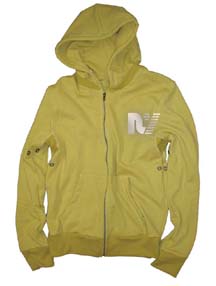 I noticed you did your Spring launch party at Kitson in LA. How did you go about making that happen?
I noticed you did your Spring launch party at Kitson in LA. How did you go about making that happen?
We’ve
just gotten great support from very successful and talented people and
[Kitson owner] Fraser [Ross] is one of them. He’s one of our biggest
supporters. We were having lunch with him one day, and he suggested the
idea of a party. It’s something we had been thinking about too, so it
just made sense.
What stores is Rebel Yell in?
Kitson, Lounge, Intermix. We’re in all the boutiques I’ve ever wanted to be in.
Do you have a website?
We don’t. We’re
debating about whether or not to do one. I think we will eventually, but
I don’t know. Something about having a website weirds me out. I feel
like all of a sudden there’s no mystery left if people know too much
about Rebel Yell.
Like what you see? Shop for Rebel Yell gear at Kitson!
March 22nd, 2006
Next Posts
Previous Posts
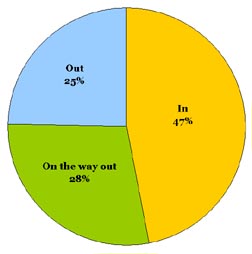
 We asked: Are Skinny Jeans In or Out?
We asked: Are Skinny Jeans In or Out?  Don: The Modus Project is a fashion, culture and lifestyle magazine, web site and fashion event. It’s a collaboration between Primedia’s Action Sports Group (ASG) and the students at Otis College of Art + Design. We (at the ASG) provide the publishing backend, but the kids at Otis are the creative engine behind the Modus Project.
Don: The Modus Project is a fashion, culture and lifestyle magazine, web site and fashion event. It’s a collaboration between Primedia’s Action Sports Group (ASG) and the students at Otis College of Art + Design. We (at the ASG) provide the publishing backend, but the kids at Otis are the creative engine behind the Modus Project. O: Can you give us a preview of what’s going to be in the magazine?
O: Can you give us a preview of what’s going to be in the magazine?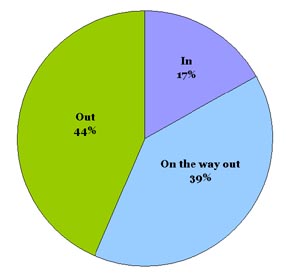
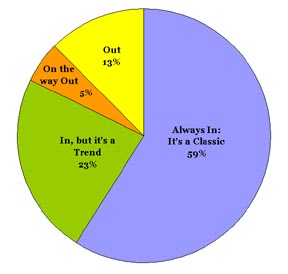
 Omiru: How did you get into the fashion industry?
Omiru: How did you get into the fashion industry? O: Describe a typical day as a stylist.
O: Describe a typical day as a stylist.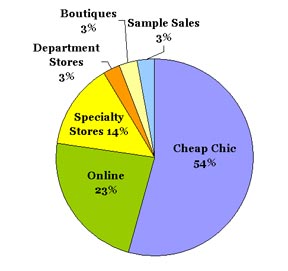
 Omiru: How did you get started in fashion design?
Omiru: How did you get started in fashion design?
 O: How many t-shirts do you come up with per season?
O: How many t-shirts do you come up with per season?

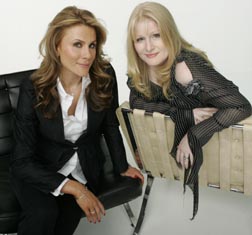

 What’s a day in the life of a fashion event organizer like?
What’s a day in the life of a fashion event organizer like?  How and when did your interest in fashion design start?
How and when did your interest in fashion design start? Do you follow trends?
Do you follow trends? What’s
What’s I noticed you did your Spring launch party at Kitson in LA. How did you go about making that happen?
I noticed you did your Spring launch party at Kitson in LA. How did you go about making that happen?